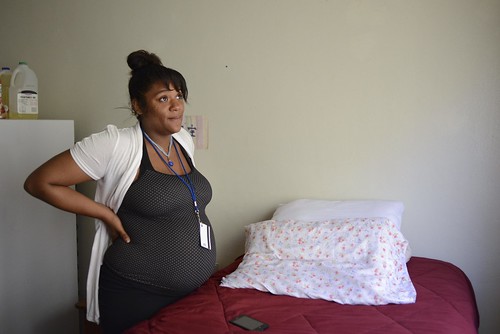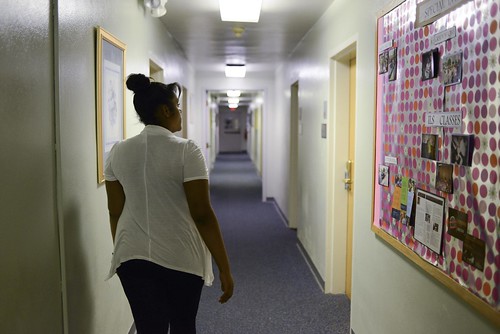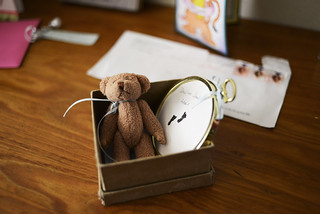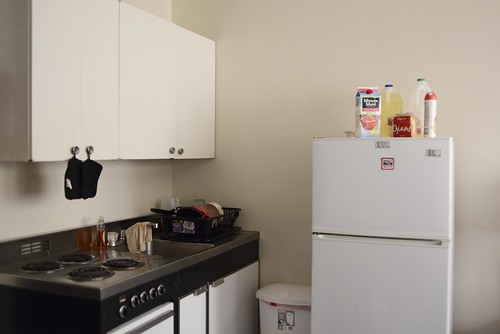Teen mom welcomes baby girl
Our cover story in the September issue featured Myah Lynell Baker, an expectant teen living at the Salvation Army’s Transitional Apartments and Parenting Center.
We are happy to share that Baker gave birth to a healthy baby girl at 4:54 p.m. Friday, Sept. 5, at Crouse Hospital. Amarionna Lynell Baker weighed 7 pounds, 5 ounces and was 20 inches long.

In Baker’s family, every female has “nell” in the middle name after her grandmother, Bridget Dynell. So Baker carried on the tradition, and she is calling her daughter Amari.
While Baker’s mother was not able to make it to the hospital, she stayed on speakerphone the entire time Baker was in labor, talking her through the process. Baker’s mother continues to call her daughter every morning.
We caught up with Baker when Amari was only 4 days old.
Baker recalls that on the morning of Sept. 5, she began to have slight labor pains and opted to walk the hallways of the Parenting Center for relief. By 1 p.m., labor was in full force, and an ambulance was called to take her to the hospital. Not long after Baker got settled in at the hospital, Amari was born. The pair stayed at the hospital two days and returned home Sunday, Sept. 7.
The biggest surprise, Baker says, is what she calls her baby’s mean streak.
“She has a good mean face,” Baker joked. “She grunts or gives a growl if I move her and doesn’t want me fussing with her. She likes to just be left alone.”
It was obvious baby Amari was in charge. For example, when the pacifier falls out of her mouth, she gives a look — “that mean look” — to Baker, conveying, “Why haven’t you put my pacifier back in my mouth?”
As Baker attempted to wake her daughter for a final photo, Amari snapped back at her mom’s touch and then gave a little hiss of displeasure. But during our visit, we mainly witnessed peaceful baby snores and happy sleep smiles.
Created with flickr slideshow.
Expectant teen mom finds a new home and life at the Salvation Army’s Parenting Center
The distinct black-and-white sonogram is displayed proudly on door 223 on the second floor of the Salvation Army’s Transitional Apartments and Parenting Center, where soon-to-be-teen mom Myah Lynell Baker now lives.
Having arrived here at 17 when she was four months pregnant, Baker cannot imagine raising her daughter, due in mid-September, anywhere else.

Inside her space, one of 24 efficiency apartments, another sonogram image hangs on the refrigerator, and more recent sonograms of her daughter are kept tucked away in a drawer. The modest room holds a bed, space for a crib, desk, galley kitchen and private bathroom with a shower and tub adjacent to the entrance. Slightly larger than a dorm room, each unit is furnished and provides Wi-Fi, but the girls tend to congregate in room 208 — the Wi-Fi hotspot.
“We’re always in there,” Baker said with a laugh. “She gets good Wi-Fi. I’m not gonna lie — it’s wonderful.”
Having Wi-Fi is just one small perk that the Parenting Center provides residents, who previously were homeless, bouncing from couch to couch, some with a child in tow. Now at the center, each resident has a private and permanent apartment.
THE ARRIVAL
At six weeks pregnant and homeless, Baker was directed to the Parenting Center by Ed Schoeneck, a case manager

at the Salvation Army who works with runaway and homeless youth.
“When I hear a teen who is homeless is pregnant, the Parenting Center is the first place that comes to mind,” Schoeneck said. “It is a great program with affordable rent that public assistance works directly with.”
Baker went to Schoeneck as a self-referral, meaning she made the initial outreach. After a few meetings with Schoeneck, who says he simply provided information about resources, Baker independently secured public assistance.
“There were many times I was not in contact with her,” said Schoeneck, who said she was bouncing from house to house of her friends and had no cellphone.
“I give her a lot of credit,” he added, “because she took the reins and took care of securing a spot at the center and getting signed up for PA (public assistance) all on her own.”
BECOMING HOMELESS
The oldest of seven, Baker says she has been raising children since she was 8 years old. She describes her day-to-day life before living at the center as unstable, her family unsupportive and her outlook uncertain.

She gives the following account. At age 12, Baker was sent back to her mother by her grandmother, who had mainly raised her. But shortly after Baker moved back, an acquaintance of her mother made advances toward Baker and she ran away, moving in with her father. At 14, she left there to stay with her boyfriend in his mother’s basement. By 15, she became pregnant with her first child.
Baker says she was happy, despite often being beaten by the boyfriend she initially viewed as her “savior.”
And from the first baby’s father, Baker contracted gonorrhea and chlamydia, she says. Both went untreated and led to inflammatory pelvic disease.
The baby’s father knew he was infected, but kept this from Baker. She discovered it when she overheard a phone conversation. “The other girl would argue with him and said, ‘that’s why it’s burning.’ So I asked him about it, and he told me ‘that’s what she says to me all the time, but then she later says she’s just playing.’”
But Baker says she told him, “That’s not something you play about.”
Baker then visited The STD Center located in the basement of the John H. Mulroy Civic Center downtown on Montgomery Street and got tested. She was told she had contracted sexually transmitted diseases and had them for a long time, despite showing no symptoms.
“Doctors told me while I was pregnant with my son that he wasn’t going to make it and that I needed to be on bed rest,” Baker said.
Shortly after becoming pregnant, she moved back in with her father, who now was living in Oswego. There she says she was kept isolated and says her father took advantage of her delicate state. “For example, he would make me late for the bus, so I would then have to walk to school … just little things, putting added stress on my body,” Baker said.
In her third trimester while at school, Baker left class to go to the bathroom and discovered her son’s umbilical cord hanging out. She was rushed to the hospital, where she learned he had been dead for two weeks.

When she arrived at the hospital, doctors induced her and she delivered a stillborn baby Sept. 12, 2012.
She named him Dav’ion Jahmel. After two days at the hospital completely alone, she returned to her father’s home, where she says family members reveled in the end of the pregnancy.
Later during a visit to the STD clinic, Baker says she was told that due to the damage from losing the fetus and the inflammatory pelvic disease, it was unlikely she would ever conceive again.
“So I thought my chances were never,” she says as she wipes away tears thinking back to her stillborn son.
Two weeks after her father moved back to Syracuse in January 2013, she sneaked out the window and spent the next year and a half bouncing between friends’ houses until she found herself pregnant again — this time by another man. She says before they became intimate, both visited the clinic and got tested. Each one was negative, and because she did not think she could ever become pregnant, they did not use protection.
Once she learned she was pregnant, the father distanced himself and is no longer in the picture.
“I’m in it alone,” Baker said, “but I’d rather be alone than unhappy.”
However, Baker isn’t really alone. Now she has the support of the staff and other residents at the center.
THE PARENTING CENTER
Here, teen girls gain independence, stability and support. Baker said the staff members arrive each day with

smiles on their faces, help residents with anything they need — physically and emotionally — and listen without judgment.
The center employs five full-time staff members: a director, a case manager, intake coordinator and two full–time resident managers.
An additional 20 part-time workers are employed, ensuring the center is staffed 24 hours a day. Funding for the program is primarily through the U.S. Department of Housing and Urban Development, along with New York State Supportive Housing Program, the United Way, Emergency Shelter Grant and rent paid by residents.
Residing at the Parenting Center provides much more than a mailing address. Residents receive and are required to participate in independent living skills training, house meetings, health consultations and parenting and childbirth classes.
Girls must also follow the detailed list of rules, regularly meet with case manager Linda Schofield, continue with their education and follow through with job training programs.
 “You don’t get to live here and do nothing,” Baker said. “They make you work towards being something, and being here … it makes you feel like you’ve accomplished something.”
“You don’t get to live here and do nothing,” Baker said. “They make you work towards being something, and being here … it makes you feel like you’ve accomplished something.”
The Parenting Center’s program director, Sheila Cooper, says to be eligible, girls must be homeless, be between the ages of 16 and 21, have no more than two children and have the ability to pay rent.
Rent is $230 a month for a single resident, $268 a month for a tenant with one child and $309 a month for a tenant with two children. Rent is directly paid to the center for residents on public assistance who also typically receive $526 a month in cash benefits for a single woman with one child and $367 in food stamps.
“We are the only program like this where (the teens) can earn an income on their own through public assistance, being only 16, because we are considered a supportive, supervised environment,” Cooper said. “Otherwise, you have to be 18 to get your own PA (public assistance) case.”
FOLLOWING THE RULES
To be accepted at the center, potential residents must pass three interviews, says Sarah Roche, parent case aid and intake coordinator. The intention is to determine not only that the residents are a good fit for the center, but also that the Parenting Center is a good fit for them.

“This is a voluntary program,” Roche said. “We have a zero tolerance policy for violating rules. Attending parenting classes, following the curfew and attending school — these are nonnegotiable.”
But when girls follow the rules and participate in the provided classes, special perks are provided, such as free laundry and meals.
“You’re rewarded for everything you do,” Baker said. “As long as you do it.”
Roche’s main job is leading such classes and ensuring girls understand the rules. She sets up three initial appointments with potential residents.
The first is an intake meeting to get to know the girl and verify her homelessness. Confirmation can come in the form of a letter from someone stating that the girl’s current dwelling is temporary and that she will be evicted within 14 days.
In the second appointment, Roche meticulously goes through the rules, line by line.
In the third meeting, a group interview by all the full-time staff is conducted.
“These are teenagers. During a rules meeting, they are rolling their eyes and thinking they want to be anywhere but here,” Roche said.
Some girls even say, ‘I’m 18, and you can’t make me follow curfew,’ but becoming a resident here is a choice, and the 11:30 p.m. curfew is in place for the safety of the residents and their child(ren).”
FROM CHAOS TO SELF-SUFFICIENCY
Case manager Schofield helps residents maneuver the transition from not knowing where they will sleep each night to the structure of the center.
 “When you’ve been couch surfing and coming and going around as you please, then settling down into a living situation where there are rules can be really hard,” Schofield said. “Many have not come from households where calm and order were modeled; they come from great chaos.”
“When you’ve been couch surfing and coming and going around as you please, then settling down into a living situation where there are rules can be really hard,” Schofield said. “Many have not come from households where calm and order were modeled; they come from great chaos.”
Schofield’s main objective is to help the girls work toward self-sufficiency.
“Our case management is holistic,” Schofield explains, emphasizing how the staff members ensure every facet of the girls’ lives gets evaluated. “If the lady has a mental disorder, then we set up a plan that includes mental health services … or someone may have custody issues and need legal support.”

It is mandatory that residents work on their education. Schofield says within one month of admission to the center, girls must be enrolled in a school program if they have not yet obtained their GED or equivalent.
Schofield, who is required to meet with the girls twice a month, helps girls with additional details, such as gaining independent living skills and securing child care.
“Also, if they are not pregnant but currently have a child, we strongly suggest that they set a goal for family planning and pregnancy prevention,” Schofield said.
“We know how hard it is to do all of this with one child; it’s exponentially more difficult with two.”
Schofield, who cried with Baker in her final intake interview, says Baker is the ideal type of resident the center seeks because she is teachable.
“These are the types of residents we love to have live here because they are the ones that are going to launch successfully,” she said. “They are going to leave better than when they came and will remember the little pieces of wisdom and apply them.”
— Feature by Ashley Kang, The Stand Director
 The Stand Syracuse
The Stand Syracuse

